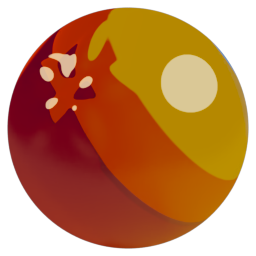
asToon¶
A Non-Photo-Realistic/NPR [Gooch:1998:NLM:280814.280950] toon shader.
Parameters¶
Incandescence Parameters¶
- Incandescence Weight
- The amount of incandescence, not restricted to an upper bound of 1.0.
- Incandescence Attenuation
- The amount of attenuation for the incandescence, based on the facing ratio towards the viewer. A high value will darken the values towards the edges.
Toon Control¶
- Incandescence Tint
- The incandescence color.
- Blending Mode
The blending mode for the Incandescence Tint parameter. It can be one of the following modes:
- Darken
- Multiply
- Color Burn
- Linear Burn
- Lighten
- Screen
- Color Dodge
- Linear Dodge
- Overlay
- Soft Light
- Hard Light
- Vivid Light
- Linear Light
- Pin Light
- Difference
- Exclusion
- Subtract
- Divide
- Hue
- Saturation
- Color
- Luminosity
See also
The node asBlendColor for more details.
- EDF Dark Color
- The color to use in the darkest areas of this term [1].
- EDF Dark Level
- The threshold at which to transition from darkest tones to mid-tones.
- EDF Midtone Color
- The color to use for the mid-tones.
- EDF Midtone Level
- The threshold at which to transition from mid-tones to bright areas.
- EDF Bright Color
- The brightest color.
- EDF Softness
- The transition softness between the tonal areas.
Advanced¶
- Normalize by Area
- When unchecked, the incandescence term is constant. When checked, it’s scaled by the surface area of the object. With deforming or scaling objects, the incandescence might therefore change in order to keep the same energy level being emitted per surface area.
Diffuse Parameters¶
- Diffuse Weight
- The contribution of the diffuse term to the toon shading, between 0 and 1.
Toon Control¶
- Diffuse Tint
- The color for the diffuse term.
- Blending Mode
The blending mode for the Diffuse Tint parameter. It can be one of the following modes:
- Darken
- Multiply
- Color Burn
- Linear Burn
- Lighten
- Screen
- Color Dodge
- Linear Dodge
- Overlay
- Soft Light
- Hard Light
- Vivid Light
- Linear Light
- Pin Light
- Difference
- Exclusion
- Subtract
- Divide
- Hue
- Saturation
- Color
- Luminosity
See also
The node asBlendColor for more details.
- Shadow Color
- The color to use in the shadow areas, or umbra.
- Shadow Level
- The threshold at which to transition from shadow to mid-tones.
- Midtone Color
- The color to use for the mid-tones, or penumbra.
- Midtone Level
- The threshold at which to transition from mid-tones to bright areas.
- Highlight Color
- The bright areas color.
- Diffuse Softness
- The transition softness between the tonal areas.
Specular Parameters¶
- Specular Weight
- The amount of specular highlights to add to the shading, between 0 and 1.
- Specular Roughness
- The apparent surface roughness of the specular highlights. This works in conjunction with the Specular Softness parameter to determine the softness of transition from highlights to non lit area. If you want soft highlights, increase roughness and Specular Softness. If you want bigger yet sharper highlights, increase roughness and keep the Specular Softness low.
- Index of Refraction
- The index of refraction for the specular term, with high values increasing the reflectivity, and low values decreasing it. This also works in conjunction with the Specular Softness control.
Anisotropy¶
- Anisotropy Amount
- Overall intensity of the anisotropy, with a value of 0.0 representing a isotropic specular highlight, and 1.0 fully anisotropic along the main anisotropy direction.
- Anisotropy Angle
- Rotation angle for the anisotropic highlight in [0,1], mapping a rotation from 0 to 360 degrees.
- Anisotropy Mode
Toggles between accepting a direct texture map in the form of an anisotropy vector map, or between an explicit vector (or a connection to a node that generates such a vector [2] ). It can take the values
- Anisotropy Map
- Explicit Vector
- Anisotropy Map
- Also known as tangent field, encodes the anisotropy directions along X and Y in the Red and Green or Red and Blue channels of the image. Appleseed expects values encoded in the Red and Green channels. Valid when the Anisotropy Mode is set to Anisotropy Map only.
- Anisotropy Direction
- The explicit vector passed as the anisotropy direction. Valid when the Anisotropy Mode is set to Explicit Vector only.
Toon Controls¶
- Specular Tint
- The color for the specular term.
- Blending Mode
The blending mode for the Specular Tint parameter. It can be one of the following modes:
- Darken
- Multiply
- Color Burn
- Linear Burn
- Lighten
- Screen
- Color Dodge
- Linear Dodge
- Overlay
- Soft Light
- Hard Light
- Vivid Light
- Linear Light
- Pin Light
- Difference
- Exclusion
- Subtract
- Divide
- Hue
- Saturation
- Color
- Luminosity
See also
The node asBlendColor for more details.
- Glossy Color
- The color to use for the specular highlights.
- Glossy Level
- The threshold at which to transition from specular highlights to areas without specular highlights.
- Glossy Softness
- The transition softness between the highlights and areas without highlights. This works in conjunction with Specular Roughness, since a very rough specular highlight will still look sharp if the threshold between the lit areas have a harsh transition. On the other side this gives the user the ability to increase the size of the specular highlights, or decrease them, and vary their apparent softness independently.
- Facing Attenuation
- A viewer Fresnel based attenuation factor. Higher values decrease the intensity of the specular reflection towards the viewer.
Rim Lighting Parameters¶
- Rim Weight
- Amount of contribution of the rim lighting effect.
- Rim Tint
- The color for the rim lighting contribution blend.
- Blending Mode
The blending mode for the Rim Tint parameter. It can be one of the following modes:
- Darken
- Multiply
- Color Burn
- Linear Burn
- Lighten
- Screen
- Color Dodge
- Linear Dodge
- Overlay
- Soft Light
- Hard Light
- Vivid Light
- Linear Light
- Pin Light
- Difference
- Exclusion
- Subtract
- Divide
- Hue
- Saturation
- Color
- Luminosity
See also
The node asBlendColor for more details.
- Rim Softness
- The softness of the rim lighting effect.
Bump Parameters¶
- Bump Normal
- The unit length world space normal of the bumped surface.
- Specular Normal
- When using separate bump controls for the diffuse and specular terms, this is the unit length world space normal for the specular term.
- Bump Control
This allows the user to choose a single bump effect for both the diffuse and specular terms, or a separate bump effect for these terms. When using both, the Bump Normal parameter affects both terms. It can take the following values accordingly:
- Diffuse Affects Both
- Split Bump
Transparency Parameters¶
- Transparency
- The transparency color, affecting shadow tinting as well.
Contour Parameters¶
- Contour Color
- The overall color of the outlines.
- Contour Opacity
- The overall opacity of the outlines.
- Contour Width
- The width of the outlines on the object.
- Contour Object
- Generate the contours based on the object ID.
- Contour Material
- Generate contours based on the material ID. Objects with the same material ID will share contours.
- Contour Occlusion
- Generate contours based on depth differences between nearby points.
- Contour Creases
- Generate contours based on the creases of the object [3], outlining sudden changes of the surface.
- Occlusion Threshold
- The threshold value for the depth difference comparison between nearby points
- Crease Threshold
- The threshold value for the creases based outlining, where low values result in outlines for smaller changes in the surface of the object.
Matte Opacity Parameters¶
- Enable Matte Opacity
- Parameter that toggles matte holdouts.
- Matte Opacity
- Matte opacity scaling factor.
- Matte Opacity Color
- Holdout color.
Outputs¶
- Output Color
- The toon BRDF output color.
- Output Transparency
- The resulting transparency color.
- Output Matte Opacity
- The matte holdout.
Screenshots¶

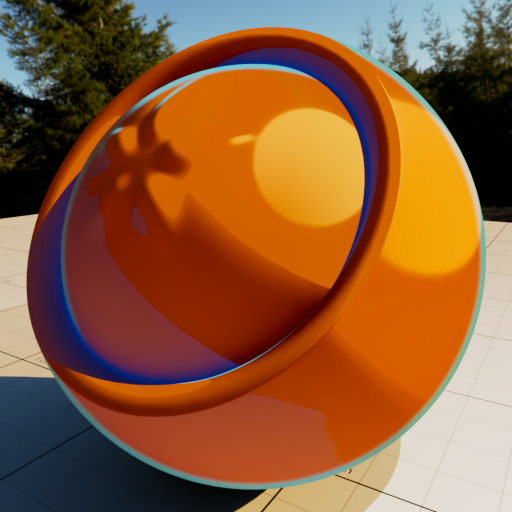


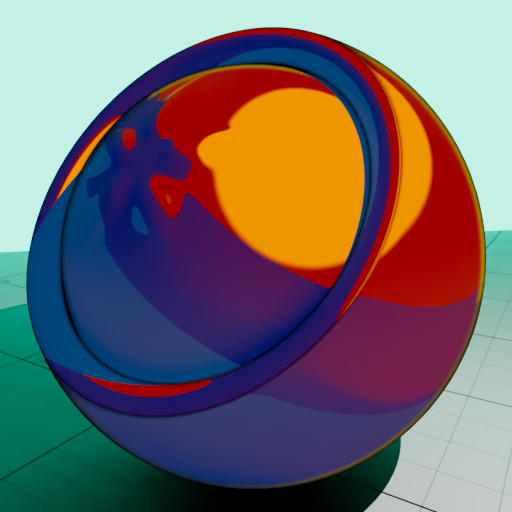
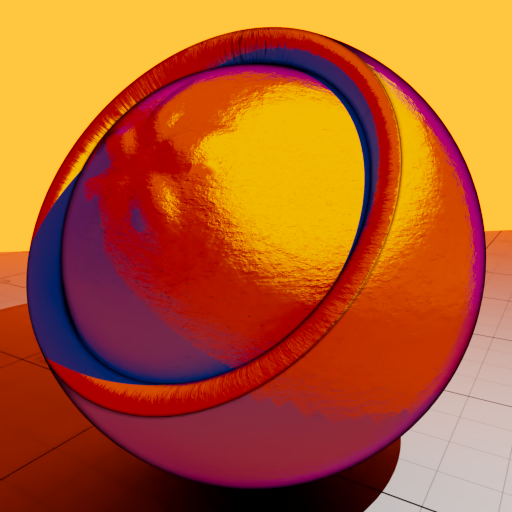


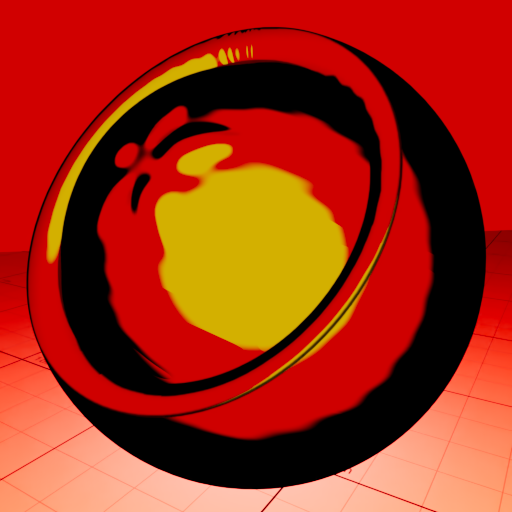
Footnotes
| [1] | Emittance Distribution Function. |
| [2] | Such as the anisotropy vector field node. |
| [3] | Based on the partial derivatives of the surface normal N along the U and V directions. |
References
| [GGSC98] | Amy Gooch, Bruce Gooch, Peter Shirley, and Elaine Cohen. A non-photorealistic lighting model for automatic technical illustration. In Proceedings of the 25th Annual Conference on Computer Graphics and Interactive Techniques, SIGGRAPH ‘98, 447–452. New York, NY, USA, 1998. ACM. URL: http://doi.acm.org/10.1145/280814.280950, doi:10.1145/280814.280950. |
